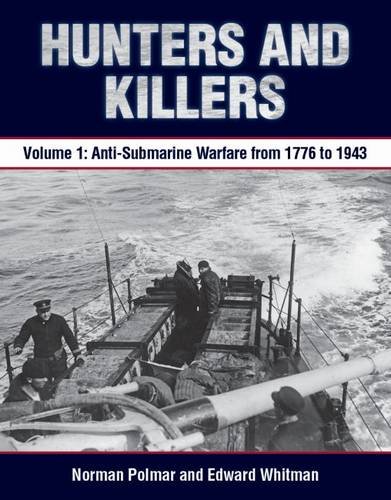Hunters and Killers; Volume 1: Anti-Submarine Warfare from 1776 to 1943 and Volume 2: Anti-Submarine Warfare from 1943
Norman Polmar and Edward Whitman

 With these two quite short volumes, Norman Polmar and Edward Whitman set themselves the ambitious goal of covering the entire history of anti-submarine warfare from the origins of submarines to the present. It is a huge task to synthesize the extensive literature of submarine warfare into a clear, analytical, and competent historical summary that can satisfy both general readers and specialists. Overall, the authors do remarkably well.
With these two quite short volumes, Norman Polmar and Edward Whitman set themselves the ambitious goal of covering the entire history of anti-submarine warfare from the origins of submarines to the present. It is a huge task to synthesize the extensive literature of submarine warfare into a clear, analytical, and competent historical summary that can satisfy both general readers and specialists. Overall, the authors do remarkably well.
Volume 1 covers the anti-submarine campaigns of both world wars up to the point at which the Battle of the Atlantic turned in favor of the Allies. I and II. Its primary focus is on the efforts by the British and, later, Americans to defeat Germany’s U-boats in the Atlantic and, to a lesser extent, in coastal waters and the Mediterranean. Although they set a start date of 1776, the authors generally devote little effort to the early history of the submarine, nor do they much cover other navies’ submarine or anti-submarine campaigns up to 1943 since, correctly, they view operations against the U-boats as the critical issue.
Volume 2 begins by documenting the second phase of World War II: the Allies’ crushing defeat of the U-boats (despite the advent of potentially dangerous submarine types very late in the war), the parallel effectiveness of American anti-submarine operations in the Pacific, and the devastating losses of Japanese merchant shipping at the hands of submarines of the United States Navy. Then the Cold War brought new anti-submarine warfare challenges, in the form of large-scale Soviet exploitation of German electro-boat technology, followed by the rapid adoption of nuclear-powered submarines by all major navies and the creation of ballistic missile submarine forces. The authors shift their focus to the interplay between the submarine and anti-submarine forces of the United States and Soviet Union as both sides contended with the technological challenges these developments brought.
Several broad themes emerge from these two volumes. Since submarines throughout the period in general represented the technological cutting edge, an essential component for successful anti-submarine warfare was the application of cutting-edge science and technology. Detection of submarines using sonar, radar, or from their sound emissions, heat signatures, or magnetism all depended on the application of science and technology to the problem. Similarly, weaponry—depth charges, ahead-throwing weapons, homing torpedoes, and so on—all required advances in technological capability. Furthermore, effective use of detection systems and advanced weaponry necessitated scientific research and operator training.
A second theme is how often the difference between an effective or an ineffective approach hinged on subtleties. Huge efforts could be expended implementing ideas that did not work, such as the large patrol forces deployed in both world wars. Sometimes effective methods required long periods of development and dedicated training and coordination to work, such as ahead-throwing weapons and sonar or the coordination of surface anti-submarine forces with aircraft.
The work’s other very important message relates to scientific and technological advances. There was a dramatic rise in the rate at which successful scientific achievement in anti-submarine warfare increased from early in World War I until towards the end of World War II. Thereafter, there has been a constant race for supremacy between submarine design and countermeasure development, both in research and applied technologies. The authors, at least, are of the opinion that submariners are ahead of those seeking to locate and destroy them at present.
Although quite a large part of the material in these two volumes is available in the existing literature, the authors ultimately succeed admirably in achieving their goal. In the process they also bring together this information in a most convenient and accessible format.
- Annapolis: Naval Institute Press, 2015 & 2016
- 8-3/4” x 11-1/4”, hardcover, 210 & 254 pages
- Photographs, figures, sidebars, tables, bibliography, indices. $44.95 & $49.95
- ISBN: 9781591146896 & 9781612518978
Reviewed by Paul E. Fontenoy, North Carolina Maritime Museum
